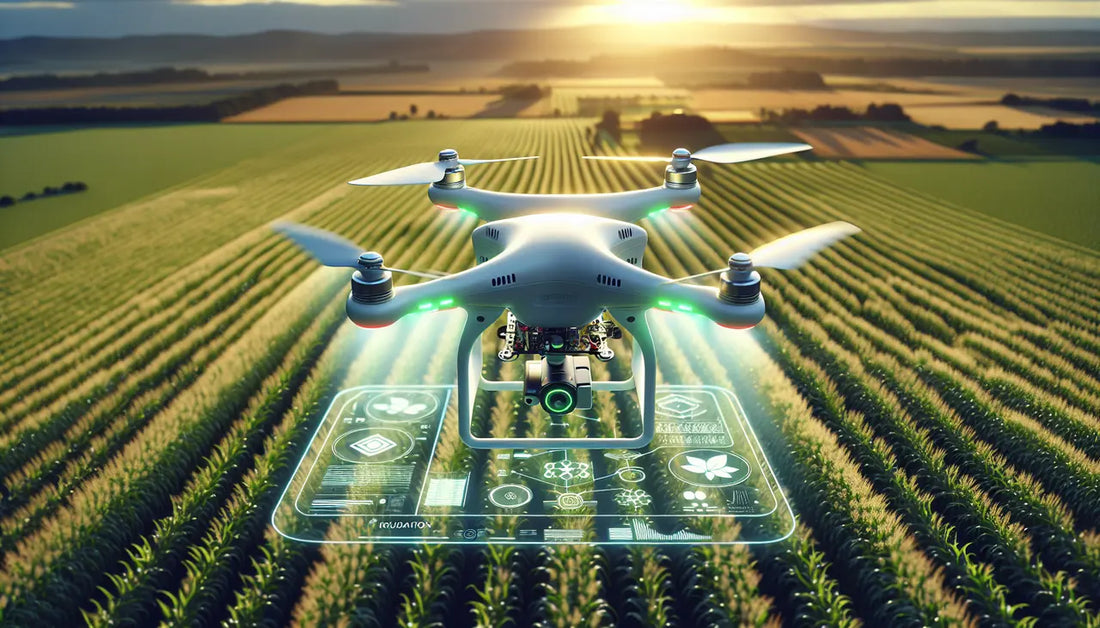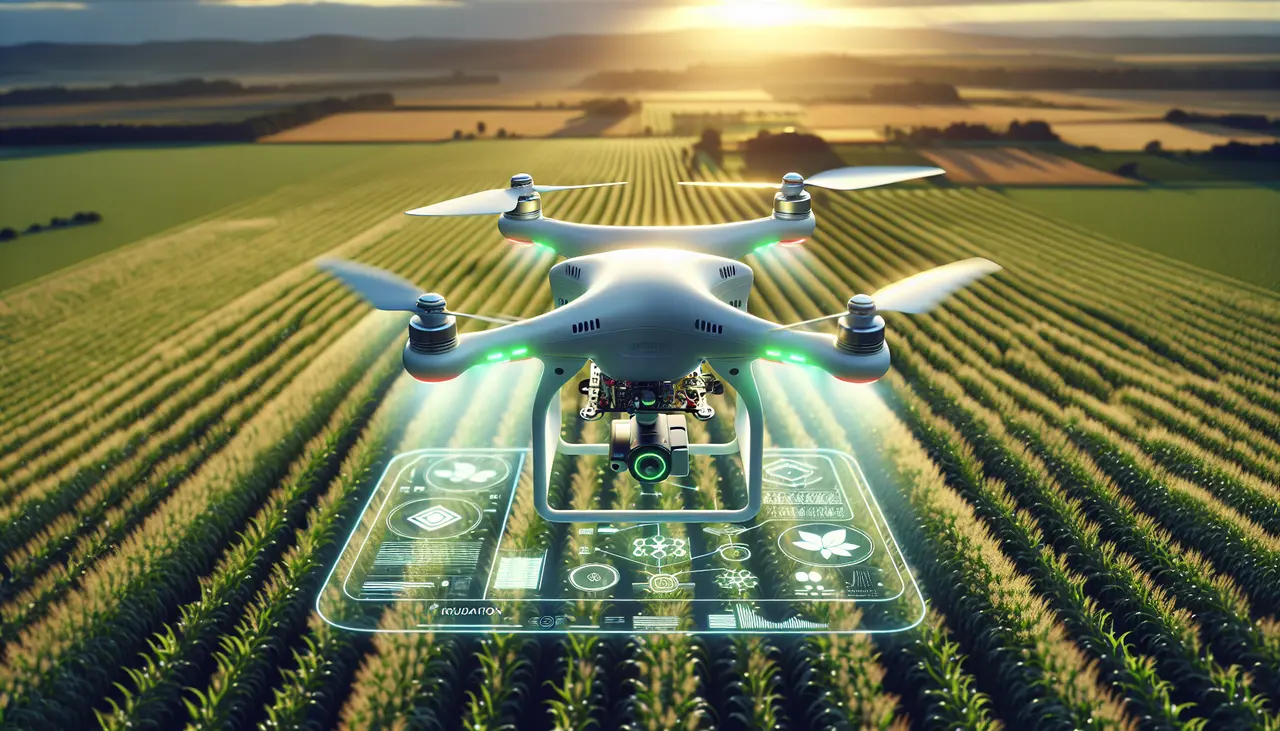
DJI Drones: Revolutionizing Crop Monitoring and Management
Share
Introduction to DJI Drones in Agriculture
DJI drones are changing the game in farming. Imagine flying cameras that can zip across your fields, giving you a bird’s eye view of your crops. That’s what DJI drones do. They make it simple to check on crop health, monitor growth, and even spot problem areas without stepping a foot outside. These drones aren’t just fancy toys; they’re powerful tools that use special cameras to see what the naked eye can’t—like changes in plant health long before problems become visible. With a DJI drone, you can quickly map out your farm, track changes over time, and make smart decisions about where to focus your efforts. It’s like having a superpower that lets you be everywhere at once, making sure your crops are healthy and thriving. Whether it’s spotting a patch of disease or assessing drought stress, DJI drones give farmers the upper hand in managing their lands more efficiently and productively.
The Evolution of Crop Monitoring: From Manual to High-Tech
Before drones became a game-changer in agriculture, farmers had to rely on manual, ground-based observations for crop monitoring. This meant long hours of walking through fields, making visual assessments, and sometimes missing crucial details that could affect the entire yield. It was a method full of guesswork and often, inaccuracies. But, as technology has soared, so has the precision in crop management. Enter DJI drones, leading the shift towards high-tech agriculture. These drones have equipped farmers with the ability to view large expanses of land from above, offering critical data and insights that were once unattainable through traditional methods. With aerial imagery, farmers can now detect issues like pest infestations, signs of disease, and water stress in crops much more efficiently. This isn’t just about taking pictures from the sky; it’s about gathering detailed, actionable information that can lead to smarter, more informed decisions on the farm. The transition from manual to drone-assisted monitoring has revolutionized not just how we grow food, but also how we ensure its sustainability for future generations. The evolution has made it clear - the future of farming is in the air.
The Role of DJI Drones in Precision Agriculture
DJI drones are changing the game in farming. Forget the old days of walking through fields for hours to check on crops. Now, farmers use DJI drones to fly over their land, getting a bird’s eye view in minutes. This isn’t just about saving time. These drones carry cameras and sensors that can tell a farmer a lot about their crops. They can spot which plants are healthy and which ones need some help. They identify areas that are too dry or spots where pests are causing trouble. This means farmers can act fast, targeting exactly where they need to water, fertilize, or spray pesticides, instead of treating the whole field the same. This smart approach is called precision agriculture. It leads to less waste, lower costs, and bigger harvests. Using DJI drones, farming is smarter, more effective, and ready for the future.
Major Benefits of Using DJI Drones for Crop Monitoring
DJI drones have changed the game for farmers and agriculturists. These flying tech pieces make checking on crops not just easier, but way more efficient. Here’s the breakdown: they save time, big time. Imagine trying to walk through acres of land to check every crop. Now, drones can do that in minutes. They fly over, snap pictures, and even collect data that helps in understanding crop health. That’s another thing; these drones are like flying doctors. They spot problem areas early. This means farmers can act fast, preventing bigger issues down the line. We’re talking about saving crops and reducing waste. Then there’s the precision. Drones don’t just look; they gather exact information on things like soil health and hydration levels. This data is gold for making smart decisions on water use and fertilization, leading to healthier crops and, eventually, higher yields. Lastly, all this tech talk translates to cost savings. Sure, drones are an investment, but they pay off by cutting down man-hours, saving on resources, and increasing crop output. To wrap it up, DJI drones in crop monitoring means saving time, spotting issues early, making precise management decisions, and saving money. It’s a win-win for modern farming.
Key Features of DJI Drones That Enhance Crop Management
DJI drones are changing the way farmers monitor and manage their crops. They come equipped with features that make crop management more efficient and less time-consuming. One of the standout features is high-resolution cameras. These cameras capture clear, detailed images of fields, allowing farmers to spot problem areas easily from the air. Another critical feature is precision mapping. DJI drones can map out farmland in detail, helping farmers plan planting patterns, irrigation, and pesticide application with high accuracy. They also offer real-time data transmission, which means farmers get immediate feedback on crop health, moisture levels, and more. This allows for swift decision-making to address any issues. Lastly, automated flight paths enable the drones to cover vast areas systematically without missing any spots, ensuring no part of the crop is overlooked. These features together transform how farmers keep tabs on their crops, saving time and increasing yield potential.
Case Studies: Success Stories of DJI Drones in Agriculture
Farmers from Iowa to India are seeing big changes in how they grow food, thanks to DJI drones. These machines are like eyes in the sky, making it easier to keep an eye on vast fields. Let’s dive into a few success stories. First up, a farmer in California used a DJI drone fitted with special cameras to spot which parts of his fields were thirsty or sick. This meant he could only water and treat the areas that needed it, cutting down his water use by 25% and saving money on chemicals. Then, there’s the story of a vineyard in France. The owner used drones to get a bird’s-eye view of the grapevines, identifying early signs of disease that human eyes missed. Acting fast helped save most of his crop, boosting the vineyard’s production by 20%. Finally, in Australia, a cattle farmer employs drones to monitor the herd. Before, checking on the health and safety of the cattle took hours of walking or driving around the farm. Now, with a quick drone flight, he can do it in minutes from a laptop. These stories show that DJI drones aren’t just cool gadgets; they’re powerful tools that can make farming more efficient, save resources, and increase yields.
How to Implement DJI Drones into Your Farming Operations
To start implementing DJI drones into your farming operations, you first need to pick the right drone. Look for models designed for agricultural use. These drones are equipped with cameras and sensors that can capture a wide range of data, from soil health to crop growth. Next, learn the basics of drone flying or hire someone skilled in piloting drones. This step is crucial because efficient use depends on skillful maneuvering. After that, integrate the data collected by the drone with your existing farm management software. This way, you can analyze the information to make informed decisions about irrigation, fertilization, and pest control. Regular use of drones for monitoring your crops allows for early detection of potential issues, leading to timely interventions. Lastly, always keep up with the latest drone technology and agricultural practices to ensure you are getting the most out of your investment. By following these steps, you’ll be able to maximize the benefits of DJI drones in enhancing your farming operations.
Understanding the Data: Analyzing Crop Health with DJI Technology
DJI drones don’t just fly around crops. They collect crucial data that show us the health of these crops, transforming how farmers manage their fields. These drones are equipped with advanced sensors that capture images beyond what our eyes can see. They look at different wavelengths of light to spot crop stress, disease, or lack of water before it becomes visible to the human eye. This early detection means farmers can act fast, saving plants and boosting yields. It’s essential to grasp how this data works. When a DJI drone flies over crops, it uses something called NDVI, or Normalized Difference Vegetation Index. NDVI measures how plants absorb and reflect light. Healthy plants reflect more infrared light and absorb more visible light, while stressed plants do the opposite. This crucial difference is picked up by the drone’s sensors, giving farmers a clear picture of crop health. By analyzing this data, farmers can make smarter decisions, like where to water more or where to apply fertilizers or pesticides. Simply put, DJI’s technology sheds light on crop health in ways impossible with just the human eye, aiming for healthier plants and higher farm productivity.
Challenges and Solutions in Adopting Drone Technology in Agriculture
Adopting drone technology in agriculture comes with its hurdles. First, there’s the cost. High-quality agricultural drones from brands like DJI aren’t cheap, making some farmers hesitate. Training is another issue. To effectively use drones, someone on the team needs to know how to operate them, interpreting the data collected can be complex. With these challenges come innovative solutions. Many companies offer training programs for drone operation tailored specifically for agricultural use, ensuring that farmers and their teams can get up to speed. Leasing options for drones have also become more common, allowing farmers to access this technology without the upfront cost of buying. Moreover, software developers are making user-friendly apps that help interpret drone data more easily, empowering farmers to make informed decisions about their crops without needing a degree in data science.
The Future of Farming: Predictions and Developments in Drone Technology
Drones are changing the game in agriculture, folks. This isn’t about taking pretty pictures—this is about feeding our future. With advancements in drone technology, farmers are now equipped with flying helpers that can scout hundreds of acres in a blink, way faster than any human or tractor could. You’ve got drones analyzing crop health, spraying pesticides with laser precision, and even planting seeds. It’s like having a superpower.
Now, imagine drones that can detect plant diseases before they spread, equipped with sensors so advanced they can tell when a plant needs water. That’s not sci-fi; it’s our tomorrow. We’re talking about reducing water usage and chemicals, saving money, and boosting yields.
Experts say we’re moving towards drones powered by AI, learning from every flight to make smarter decisions for the farm. And with regulations getting friendlier for drones in agriculture, the sky’s literally the limit.
In the not-so-distant future, we might even see drone swarms, working in sync to tackle big farming tasks faster than ever. From solo flyers to swarm intelligence, this tech is evolving. The goal? To make farming more efficient, less resource-heavy, and ready for the challenges of feeding a growing planet.
So, yeah, drones in farming? They’re here to stay and only getting better. Keep an eye on the sky—it’s where the future of farming is taking off.

